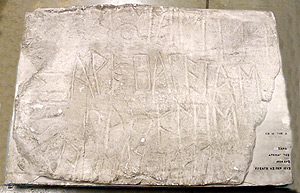Plaster Cast: Gravestone Inscription
1900.11.0103
Detailed Images
Basic Information
| Artifact Identification | Plaster Cast: Gravestone Inscription (1900.11.0103) |
|---|---|
| Classification/ Nomenclature |
|
| Artist/Maker | Emile Gillieron & Fils, Athens. |
| Geographic Location | |
| Period | Archaic |
| Date | 650 - 550 BCE |
| Culture | Ancient Greek |
| Location | Not on Exhibit |
Physical Analysis
| Dimension 1 (Length) | 92.5 cm |
|---|---|
| Dimension 2 (Width) | 63.5 cm |
| Dimension 3 (Height) | 5.7 cm |
| Weight | 25,200 g |
| Measuring Remarks | N/A |
| Materials | Plaster |
| Manufacturing Processes | Cast |
Research Remarks
| Description | Plaster cast of the front face of a large flat slab of dark grey volcanic stone, with at least nine, possibly ten names inscribed in total on its four sides in the early Theran alphabet: three words at the middle of the upper face, with two more crowded near the edges at left and bottom; five more are inscribed around each of the three low vertical sides of the slab. The text occupying the center of the upper face is (IG XII 3.762a). The letters are between ?? and ?? cm. high. The letters of the epichoric Theran alphabet are transliterated as follows: |
|---|---|
| Published Description | N/A |
| Bibliography | Fraser, Peter M. and Elaine Matthews, eds. 1987. A Lexicon of Greek Personal Names, vol. 1, The Aegean Islands, Cyprus, Cyrenaica. 1994. Oxford: The Clarendon Press for the British Academy. |
Artifact History
| Credit Line/Dedication | N/A |
|---|---|
| Reproduction | Yes, Original displayed in the Athens Epigraphical Museum. Reproduction probably made by the staff of the Athens National Archaeological Museum, perhaps Emile Gillieron & Fils, Athens. See also 1900.11.0099 and 1900.11.0102. |
Contact
All information about our collection is constantly reviewed and updated. Please contact Dery Martínez-Bonilla, Registrar, if there is any information you are looking for that isn't currently online.
